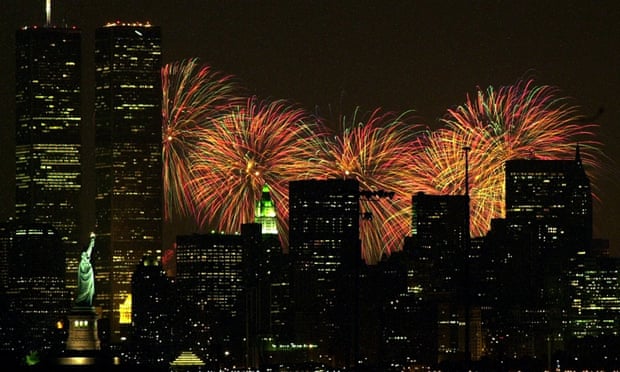The American poet was once a messenger for a Manhattan shipping company, delivering mail to offices in the newly erected twin towers. The 9/11 attacks brought memories coursing to the surface

World Trade Center/ Mail Runner/ ’73
There was no languor, no drowsy trade winds,
or stoned-out stupor of lapping waves,
only news, the big board of crime,
corporate raiding, selling short and long.
It didn’t matter, I was no Ishmael.
I just hovered there in the thick of the material –
at the edge of a skyline of money,
rising in a glass box.
It was comic to think Bachelard believed elevators
had destroyed the heroism of stair-climbing.
In the rush of soaring metallic, past the whiff of 4-martini lunches,
up gearless traction in transparency,
waves of cool air coming from the vents.
At the 85th in a sky lobby we stalled out and the sun
flooded the glass/the river/the cliffs.
Jersey was just gouache and platinum coming apart –
a glistening smudge
and some nagging line from Roethke I’d been reading –
circulating the air:
“It will come again. Be still. Wait.”
•“World Trade Center / Mail Runner / ’73” from Ziggurat by Peter Balakian. Copyright © 2010 by The University of Chicago. All rights reserved.
The first section of Ziggurat alternates ekphrastic poems on artworks by Andy Warhol with recollections of the World Trade Center and surrounding cityscape some 30 years before the devastation of 9/11.
Peter Balakian was a messenger for a Lower Manhattan shipping company, regularly delivering mail to offices in the newly erected twin towers. In an interview with Scott Simon he recalled the aesthetic impact of the new architecture, and how, at the time, it opened “mental spaces” for him. Subsequently, the 9/11 attacks brought these recollections coursing to the surface. Collage-like juxtaposition is primary to Balakian’s technique, and its foundation is the porosity he senses between the public zone of utterance and the private.
More
There was no languor, no drowsy trade winds,
or stoned-out stupor of lapping waves,
only news, the big board of crime,
corporate raiding, selling short and long.
It didn’t matter, I was no Ishmael.
I just hovered there in the thick of the material –
at the edge of a skyline of money,
rising in a glass box.
It was comic to think Bachelard believed elevators
had destroyed the heroism of stair-climbing.
In the rush of soaring metallic, past the whiff of 4-martini lunches,
up gearless traction in transparency,
waves of cool air coming from the vents.
At the 85th in a sky lobby we stalled out and the sun
flooded the glass/the river/the cliffs.
Jersey was just gouache and platinum coming apart –
a glistening smudge
and some nagging line from Roethke I’d been reading –
circulating the air:
“It will come again. Be still. Wait.”
•“World Trade Center / Mail Runner / ’73” from Ziggurat by Peter Balakian. Copyright © 2010 by The University of Chicago. All rights reserved.
The first section of Ziggurat alternates ekphrastic poems on artworks by Andy Warhol with recollections of the World Trade Center and surrounding cityscape some 30 years before the devastation of 9/11.
Peter Balakian was a messenger for a Lower Manhattan shipping company, regularly delivering mail to offices in the newly erected twin towers. In an interview with Scott Simon he recalled the aesthetic impact of the new architecture, and how, at the time, it opened “mental spaces” for him. Subsequently, the 9/11 attacks brought these recollections coursing to the surface. Collage-like juxtaposition is primary to Balakian’s technique, and its foundation is the porosity he senses between the public zone of utterance and the private.
More
No comments:
Post a Comment